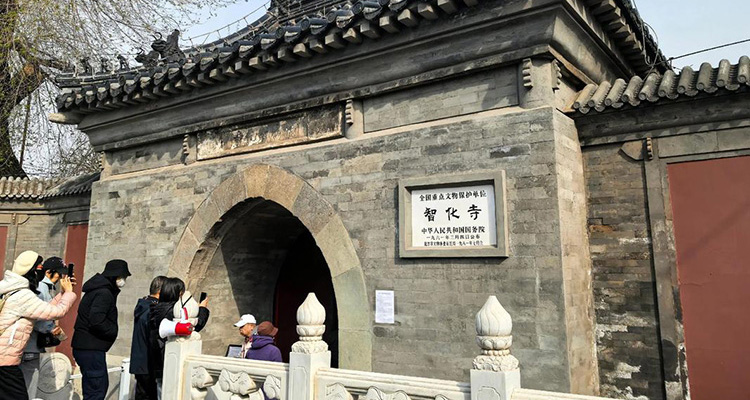A 600-Year Grain Warehouse Turned Trendy Alley
1. Time-Warp Lane: Lomicang Hutong’s Grain Warehouse Roots
Located in the southeast of Beijing’s Dongcheng District, Lomicang Hutong stretches just over 540 meters, linking Xiaopaifang Hutong in the east to Chaoyangmen South Street in the west. Its name, “Lomicang,” comes from the Ming era term for rice (“lu”) used as official salary. This alley once housed the grain warehouses that stored the government rice pay.
Back in its heyday, there were as many as 57 warehouse buildings (or lou), occupying nearly half the length of the lane. The walls were two meters thick, and many were semi-underground with ventilation windows—an ingenious design to protect the rice from humidity and pests. Today, at Nos. 71 and 73, you can still see well-preserved architectural relics from the Ming–Qing era, with rough brick walls and traditional tiled roofs echoing bygone grandeur.
Over centuries, the function of Lomicang evolved. After the 1900 foreign invasion, the stored grain was seized, and the warehouses were repurposed. During the Republic period, the site became a military uniform factory. Now, thanks to careful restoration, Lomicang has been reborn as a cultural & creative hub, blending history and innovation.

2. Heritage Meets Trend: Lomicang Hutong as Creative District
Lomicang is no longer just a heritage alley — it’s now a creative district where old warehouse bones meet new ideas. Within this urban revival zone you’ll find everything from boutique studios to digital media firms, and from art galleries to themed retail spaces.
Shopping & Boutiques
- Fulumi Rice House is a lifestyle store centered on rice culture. It sells premium rice, rice soap, five-grain fridge magnets, and more — a cool place to pick up unique souvenir items.
- Geya General Store, owned by a local Beijing couple, stocks quirky, everyday goods. They even run a “lunch blind box” for 33 RMB — you might get a warm home-style Beijing meal inside.
Cafés & Restaurants
- YiTong Yakitori BISTRO grills fresh skewers on the spot, offering limited rare cuts daily. Their signature drink “Lomicang 71” gives off a subtle grain aroma.
- Supapa Bistro fuses Zhejiang and Cantonese flavors with simple, elegant décor — try their fresh-caught yellow croaker or scallion oil chicken, paired with Burgundy wines.
- Fulumi Café is where the rice aroma mingles with coffee — their rice-wine latte is famously bold and memorable.
- Radial Coffee is a sporty, low-sugar spot offering a white-peach latte, ideal for caffeine lovers watching their sugar intake.
Arts & Culture
- Near the east entrance lies Zhihua Temple, where around 3 pm each day you can hear Beijing-style classical music — a rare living relic listed as national intangible cultural heritage.
- Fulumi also hosts intermittent art exhibitions, from macro photography to local film projects, weaving a creative vibe into this time-travel walk.

3. Explore & Enjoy: Immersive Experiences in Lomicang Hutong
Photo Ops & Landmarks
- The old warehouses at No. 71 and 73 make striking photo backdrops, with their rugged lines and sense of weighty history.
- Walk toward Xiaopaifang Hutong and you’ll hit a classic vantage point for Galaxy SOHO, where the contrast of old lanes and futuristic curves can’t help but impress.
- At Zhihua Temple, a nearly 600-year-old Ming structure with black glazed tile roofs, you can shoot the traditional architecture in a serene setting.

How to Get There
Lomicang Hutong sits east of Chaoyangmen South Street in Beijing’s Dongcheng.
- Subway: Take Lines 1, 2, 5, or 6 to Chaoyangmen Station, then walk ~13 minutes.
- Bus: Use the Lomicang stop via routes 24, 63, or Night 28.
To avoid traffic, skip rush hours (7:30–9:00 am & 17:00–19:00 pm). Use a map app (Gaode or Baidu) to guide your walk.
Best Visit Time & Duration
- Season: Spring and autumn are ideal — gentle weather for strolling.
- Hour: Weekday afternoons are perfect to dodge crowds and soak up the relaxed old-meets-new vibe.
- Time needed: Plan for 2 to 3 hours to explore warehouses, temple, shops, and cafés at a leisurely pace.
Cultural Tips
- Payment: Most shops accept mobile pay (Alipay, WeChat). Still carry a little cash for spots that don’t.
- Bargaining: Fixed-price places like Fulumi usually don’t bargain. In small creative stores like Geya, you may politely ask if there’s a discount.
- Respect locals: Some residents live within the hutong — don’t wander into private courtyards or shoot photos of them without permission. At Zhihua Temple, keep voices low and obey rules.
- Handy Chinese phrases:
“Xiè xiè” (Thank you), “Nǐ hǎo” (Hello), “Zhè gè duō shǎo qián?” (How much is this?)
Picture this: early sunlight streams onto the gray brick lanes, the bricks at No. 73 warm under the light. A resident wheels past. Ahead, Fulumi’s door swings open, and the air carries a mellow blend of rice and coffee. A fashionably dressed visitor frames a shot of a warehouse’s ventilation window. Here in Lomicang Hutong, time doesn’t just pass — it folds, pauses, echoes — in temple melodies, in a sip of rice latte, in every step along the alley.


